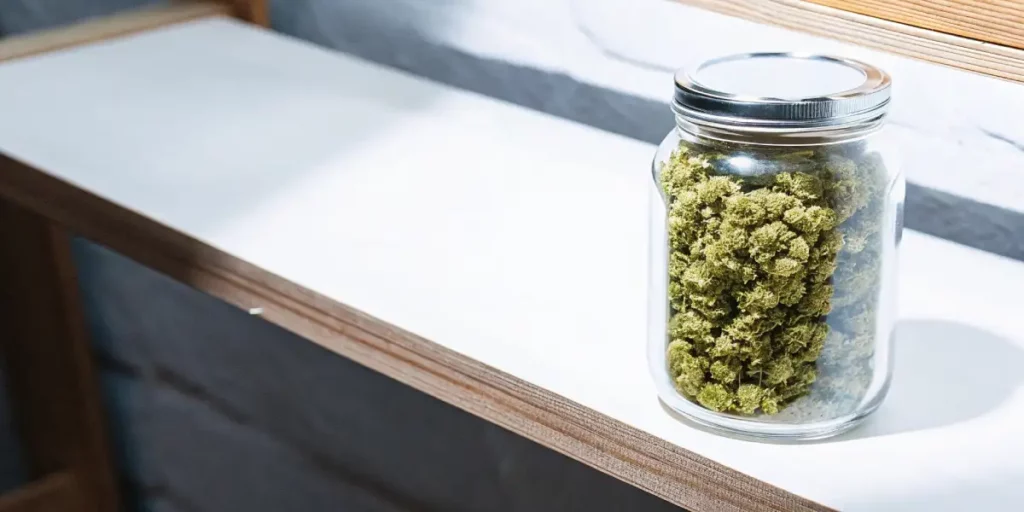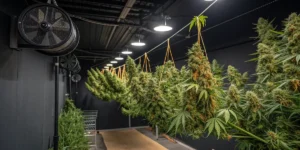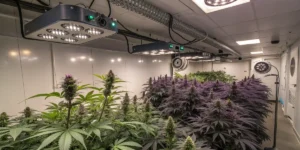Curing cannabis humidity is a crucial factor for both novice and veteran growers. It can make or break the quality of your buds. When done right, it enhances flavor, potency, and smoothness. Achieving the best results requires attention to detail, especially with humidity levels.
After harvesting, your cannabis isn’t ready to smoke. It needs curing, a process that involves controlled drying and aging. The curing cannabis humidity must be just right. Too high, and you risk mold. Too low, and your buds might become too dry and harsh. Striking the perfect balance is key.
Knowing the optimal humidity for curing cannabis is essential. A range of 55% to 65% is often recommended. This range allows the buds to release moisture slowly, preserving terpenes and cannabinoids. Let’s dive into how to control humidity when curing cannabis effectively.
Optimal Humidity for Curing Cannabis
Maintaining the optimal humidity for curing cannabis is vital. This ensures the buds continue to dry slowly without losing potency. An ideal environment prevents the degradation of valuable compounds.
To achieve the best humidity level for cannabis curing, use a hygrometer. This tool measures humidity levels. If you’re serious about quality, investing in one is a smart move. Many growers find 60% to be the sweet spot for curing cannabis humidity.
While 60% is a popular target, some growers prefer to start at the higher end of the range and gradually lower it. This method allows for a more controlled release of moisture, ensuring that the buds retain their aromatic properties. Adjusting gradually can also help in avoiding sudden changes that might shock the plant material.
Another factor to consider is the environment in which the cannabis is grown. Outdoor conditions may necessitate adjustments to the curing process. For instance, a humid climate might require a lower target humidity to compensate, while a dry area may benefit from slightly higher levels within the recommended range.
Tools and Techniques
Using the right tools can make a world of difference. A hygrometer is a must-have. It helps you monitor the ideal humidity range for curing marijuana. Some even connect to your smartphone for real-time updates.
Another effective tool is a dehumidifier. It reduces excess moisture, keeping the environment stable. If your curing space is too dry, consider a humidifier. This device adds moisture, ensuring your buds don’t become brittle.
Incorporating fans to enhance air circulation can also be beneficial. These fans should be used judiciously to maintain gentle air movement without directly blowing on the cannabis. This helps in evenly distributing humidity and avoiding pockets of stagnant air that could lead to mold growth.
For those who prefer a more hands-on approach, homemade solutions work too. Placing silica gel packs in jars can help control humidity. Be cautious, as too much can overly dry your buds. Monitoring these packs and replacing them as needed ensures that the curing cannabis humidity remains within the ideal range.
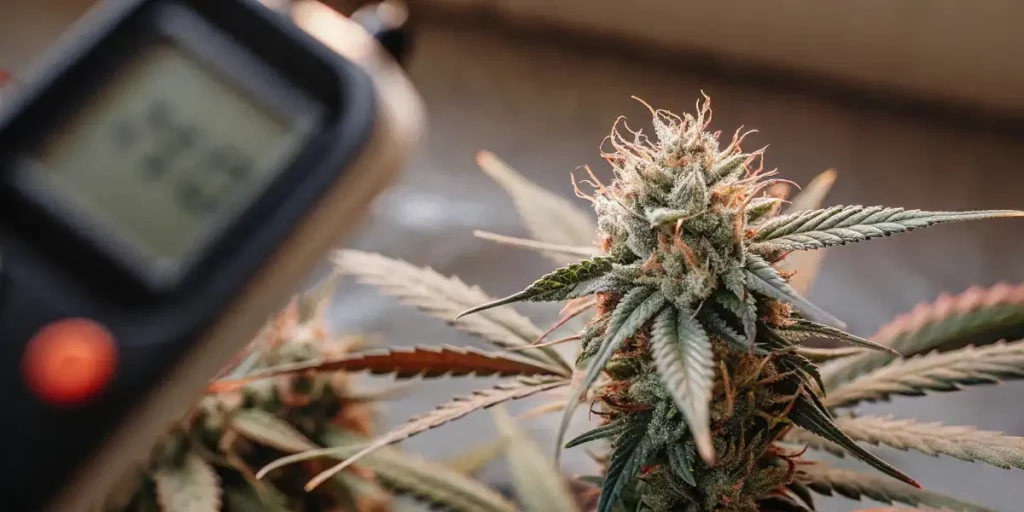
Strains to Consider
Different strains might require slight adjustments to your curing process. For example, the Pineapple Express from Global Green Genetics is known for its tropical flavors. Proper curing ensures these flavors are preserved.
Another popular choice is the Blue Dream. It’s a balanced strain that offers potent effects. Proper humidity control during curing enhances its natural sweetness.
Strain-specific nuances can affect the curing process. Indica strains, which are often denser, might require slightly longer periods within the optimal humidity range for curing cannabis to ensure even moisture distribution throughout the buds.
Sativa strains, on the other hand, which tend to be less dense, may dry quicker. Monitoring these differences closely with a hygrometer helps in fine-tuning the curing cannabis humidity for each batch, ultimately preserving the unique characteristics of each strain.
How to Control Humidity When Curing Cannabis
Learning how to control humidity when curing cannabis can save you from potential pitfalls. A simple setup can be effective. Ensure your space is sealed, limiting external influences.
Consider the environment where you’re curing. A dark, cool room is ideal. This helps maintain the best humidity level for cannabis curing. Avoid areas with direct sunlight or fluctuating temperatures.
Utilizing proper storage containers like glass jars can also aid in maintaining consistent humidity levels. These containers should be airtight but allow for periodic “burping” to refresh the air within, which is crucial for maintaining the ideal humidity range for curing marijuana.
Monitoring the curing cannabis humidity regularly, at least once or twice a day, provides insights into necessary adjustments. This proactive approach minimizes risks and ensures that your cannabis cures to perfection without unwanted surprises.
Environmental Factors
Temperature plays a role in curing cannabis humidity. Keep it around 60°F to 70°F. This range pairs well with the optimal humidity for curing cannabis.
Air circulation is another factor. Stagnant air can lead to mold, while too much airflow can dry out buds prematurely. Aim for gentle air movement.
It’s also important to consider changes in weather and seasonal variations when curing cannabis. For instance, during rainy seasons, external humidity levels might increase, making it necessary to adjust internal conditions accordingly to maintain the best humidity level for cannabis curing.
If you’re curing cannabis in a particularly volatile climate, consider using environmental control systems that can automatically adjust temperature and humidity levels. These systems provide peace of mind by ensuring that the curing process remains stable regardless of external conditions.
Additional Tips
For those in humid climates, silica packs can be lifesavers. They absorb excess moisture, keeping your buds safe. On the flip side, for dry regions, a small piece of citrus peel in the jar can add moisture.
Always label your jars with the date. This helps track the curing process. It’s easy to lose track of time, especially with multiple batches.
Maintaining a curing journal can be an invaluable tool. Documenting the environmental conditions, strain-specific observations, and any adjustments made provides a reference for future grows. This practice enables growers to refine their methods and achieve the best possible results.
Incorporating these cannabis curing humidity tips into your routine not only improves the quality of your buds but also enhances your overall growing expertise. Continued learning and adaptation are key to mastering the art of curing cannabis effectively.
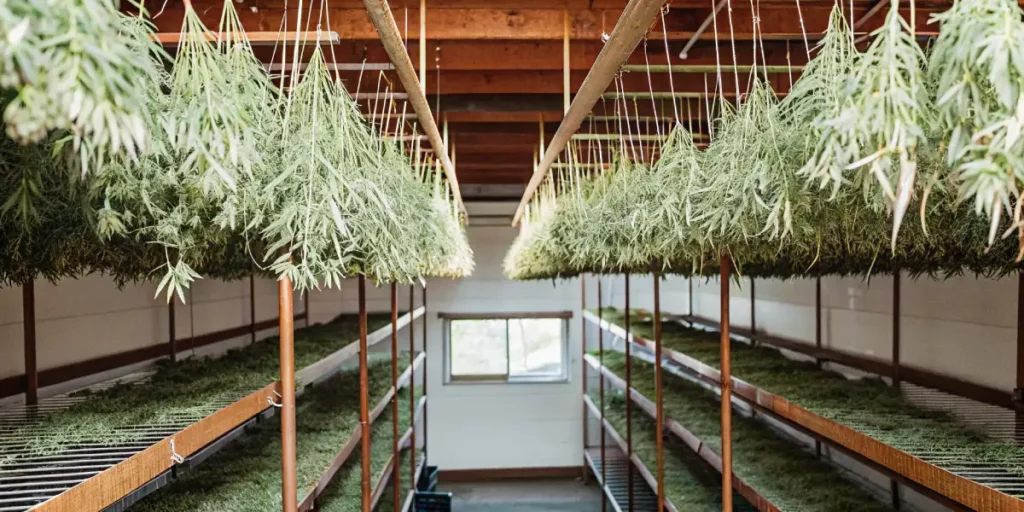
FAQs of curing cannabis humidity
What is the optimal humidity for curing cannabis?
The optimal humidity for curing cannabis typically falls between 55% and 65%. This range helps retain the bud’s moisture without promoting mold growth. It allows the cannabis to cure slowly, preserving its flavor and potency.
It’s crucial to use a hygrometer to monitor these levels. Consistent monitoring ensures that your buds remain within the desired range, minimizing the risk of spoilage or degradation.
Staying within the optimal humidity for curing cannabis not only preserves the plant’s desirable properties but also enhances the smoking experience. Proper curing results in a smoother, more flavorful end product, which is a testament to the attention paid to humidity levels.
Regularly checking and calibrating your hygrometer ensures accuracy in readings. An inaccurate device can lead to misguided adjustments, so maintaining your equipment is just as important as monitoring the curing process itself.
How can I control humidity when curing cannabis in a dry climate?
In dry climates, maintaining the ideal humidity range for curing marijuana can be challenging. One method is to use a humidifier in your curing space. This device adds moisture to the air, preventing your buds from drying out too quickly.
Additionally, placing a small piece of citrus peel inside your curing jars can help increase humidity levels temporarily. Just be cautious and remove it after a day to prevent any mold development.
For those who prefer a more sustainable approach, utilizing a water dish within the curing space can be effective. The evaporating water adds moisture to the air, helping to maintain the best humidity level for cannabis curing without the need for frequent intervention.
Monitoring and adjusting for changes in ambient humidity is key. Anomalies in weather patterns or seasonal shifts may require recalibrating your setup to ensure that your cannabis curing humidity remains optimal throughout the process.
What tools are essential for monitoring curing cannabis humidity?
A reliable hygrometer is essential for monitoring curing cannabis humidity. This tool gives you real-time data on the humidity levels inside your curing jars or room. Many modern hygrometers even offer digital readouts and smartphone connectivity.
Alongside a hygrometer, consider investing in a dehumidifier or humidifier, depending on your local climate needs. These tools help maintain stable humidity levels, ensuring your cannabis cures perfectly.
Advanced growers might also consider using environmental controllers that integrate with hygrometers and humidity control devices. These systems allow for automated adjustments, ensuring that the optimal humidity for curing cannabis is consistently maintained without requiring constant manual oversight.
For those on a budget, analog hygrometers can suffice, though they may require more frequent calibration and monitoring. Regardless of the tools chosen, the key is consistent observation and adjustment based on reliable data.
Can I use household items to control curing humidity?
Yes, several household items can aid in controlling curing cannabis humidity. Silica gel packs can absorb excess moisture, while a piece of citrus peel can add moisture if needed. These are simple solutions that can be quite effective.
However, always monitor closely when using these items. The goal is to maintain balance, so adjust your methods based on your hygrometer’s readings to avoid over-drying or mold development.
Another household item to consider is a moistened sponge placed in a perforated container within the curing space. This can add a gentle increase in humidity, which may be beneficial in particularly dry environments.
Be cautious with organic materials like citrus peels, as they can introduce additional variables such as unwanted odors or potential contaminants. It’s best to use these methods as temporary measures and rely on consistent monitoring to guide longer-term strategies.
How long should the curing process take?
The curing process can vary, but generally, it takes about two to four weeks. Some growers even suggest a longer curing period of up to six weeks for the best results. This time frame allows the buds to develop greater flavor and potency.
Patience during this stage is key. Regularly check your buds and adjust humidity levels as necessary to ensure they cure properly. Rushing the process might lead to a less satisfying end product.
Some connoisseurs extend the curing time even further, allowing the buds to age for several months. This can lead to a more refined and nuanced flavor profile as the cannabinoids and terpenes continue to mature and develop.
Ultimately, the duration of the curing process will depend on personal preference and the specific characteristics of the strain. Experimenting with different time frames can yield insights into achieving the ideal end product for your tastes.

